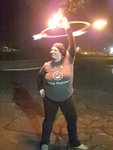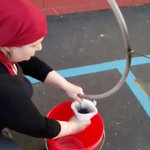

In a stressed-out, worried young 21st century, the lost art of play, in the form of hula hooping, is coming around again with centrifugal force. Lansing area hula hoopers, dancers and instructors are hooping in the streets, teaching in the schools and spreading the joy of getting into a physical and mental state of “flow,” with or without flames.
Longtime Lansing residents know the city’s capacity for entrepreneurship is at a recent high with the proliferation of movers, shakers — and now hoopers. Missy Cooke started her hula hoop business, Lansing Hoops, in 2014, after picking up the sport to reconnect with her mind and body. Now, with grant money rolling in and an instructor certification, Cooke is taking her hoops to corporate retreats and elementary gym classes to get people serious about their recreation.
Cooke said in the months leading up to her discovering hula hooping in 2014, she was “very unhappy” and needed a change in her routine. Coming home from work, her energy would be so low that is was a challenge to engage with her family at times. That year, while at a marketing conference for work, she met a professional hula hooper. Slightly skeptical, Cooke went back to her hotel room and watched YouTube videos of hula dancing.
“I was mesmerized,” Cooke said. “Hooping is almost like yoga or a moving meditation, and there are a lot of emotions that can come up during a flow or when you’re learning a new trick.”
The World of Flow
In Lansing, men and women are opting to trade in their gym memberships for what they consider to be “a more fun option,” Cooke said.
Through Lansing Hoops, Cooke has presented the benefits of hula hooping and taught basic hoop moves at school assemblies and office retreats. She is certified as a teaching artist by the Arts Council of Greater Lansing. The hula hoop is just a vehicle for a grander mission: to change the way people view exercise and help them find happiness.
Cooke said a hooper’s life philosophy is that at some point, between the struggles with self-esteem brought on by post-adolescence and getting a real job, adults forget how to play.
She brings hoops of various sizes and weights to classes to make hooping accessible for a wide variety of body types and abilities. Most participants are first-time hoopers, so she fosters an equal learning-playing environment where failure is OK. When she runs workshops in professional settings, hooping serves as an ice breaker, less forced and awkward than traditional social interactions. It’s a joyful ritual that virtually sucks all intimidation out of the room.
Once a first-time hooper nails the basics down, such as isolating their hips and arms while oscillating the ring, they will learn new tricks and work their way up to being able to flow.
Similar to the focused immersion of a work flow or being “in the zone,” flow art is a style of dance that simultaneously combines a seamless series of movements with deft prop manipulation. In addition to hooping, other flow art styles include poi, staff spinning, juggling, sphere manipulation and fan dance. The list goes on as dancers experiment with different props and dance converges with martial arts, fire spinning and other cultural expressions.
A guru of happiness frequently identified in the international flow scene is Mihaly Csikszentmihalyi, a Hungarian-American psychologist whose studies on happiness resulted in a national bestseller in 1990 called “Flow: The Psychology of Optimal Experience.” The psychologist describes flow as being in a state of total absorption.
In a 2004 TEDtalk titled “Flow, the secret to happiness,” Csikszentmihalyi breaks down the state of ecstasy he observed during his research where subjects, mostly artists, felt as though they had entered an alternate reality where one “is completely engaged in creating something.” While in a flow state, the psychologist suggests the brain is unable to monitor how the body feels and people “disappear from their identity, from consciousness.” The same feeling could be said when one is immersed in play or rigorous exercise.
The mind might jump to a scene straight out of Burning Man, a techno music festival in a remote desert in Nevada, of a shirtless man spinning balls of fire at lightning speeds around his body. This is on the right track, as the recent popularity of flow art catapulted out of the rave scene.
When it comes to the history of hula hoop dancing, the flow art form can be traced as far back as early Anishnaabe folklore of a young boy named Pukawiss who used hoops to teach others about the movements and behaviors of animals. Native American hoop dancers can use as many as 40 hoops simultaneously to tell a story about life’s overlapping elements, including animals, humans, water, air or even marriage, according to traditionalnativehealing.com, a blog for native spirituality and ceremonies.
While it’s a long way from the earliest forms of hoop dancing to the style Cooke teaches in elementary schools, its use as a tool for building community is the same.
Mother of Hoops
Jennifer Wagemann is a professional hooper living in Lansing and founder of Spinning Speakers, a collapsible hula hoop with waterproof, built-in Bluetooth speakers. In November, Cooke was one of seven recipients of the Chris Clark Fellowship, a grant administered by the Arts Council of Greater Lansing, to extend the production of her trademarked invention called the Fuel Funnel.
She said her hooping journey started 10 years ago after attending Electric Forest, formerly known as the Rothbury Music Festival.
Wagemann referred to Cooke as the “mama” of the local flow art scene. In 2015, Cooke started Michigan’s first statewide hoop dance retreat. Once a year, hoop fanatics from across the state gather at Sunset Place Campground in Mason to network and train for a week.
A few summers ago, Wagemann was living in Chicago when she discovered Cooke’s Michigan Hoop Dance Retreat was taking place 300 miles away.
“That week, I was supposed to go to a wedding with my boyfriend, but I told him I had to cancel. Luckily, he was supportive,” Wagemann said.
When Wagemann moved to Lansing, she reconnected with Cooke and flow artists, and picked up fire spinning as well as teaching with Lansing Hoops in schools. She also credits Cooke as a mentor in product development.
While practicing fire spinning, Cooke wasn’t bothered by turning her eyelashes to ash or suffering light burns on her face (as expected when in a flow.) Instead, she was concerned about the excess gasoline she was flinging on her lawn during a practice session.
The Fuel Funnel is shaped like a cone and has a handle meant to latch on to the side of a bucket of gasoline. After dousing a hula hoop’s wick into the tub of gasoline, the wick immediately goes into the funnel while a free hand squeezes the malleable funnel, acting as a drain for the wick. Viola! No excess gasoline on the lawn to poison the family dog.
While both inventors prepare to get their hooping tools on the market, Wagemann and Cooke also collaborate by booking gigs for their performance troupe, the Smitten Spinners. Last week, the eight-member tribe took their flashy, LED hoops to Williamston to flow in the town’s Parade of Lights.
The Spinners — the dancers, not the Motown group — do anything from choreographed private corporate events to roving performances. In the flow world, a roving performance is closer to what one would see at a music festival where a dancer is off stage and moving about the crowd.
Am I missing anything? Oh yeah, Wagemann and her hoop troupe will be in bar near you in March 2020. The inaugural Hoops and Hops Flow Jam, a partnership with Lansing Brewing Co., started in 2018 as a way to host hooping workshops out of a studio and into a common space.
The jam opens with a beginner class with a live DJ and the talent progresses as the night goes on. Cooke said the Smitten Spinners will also have a number prepared.
The trend apparent in Lansing’s flow art scene is how the performance-based exercise is converting into entrepreneurial venture for women. The holistic hobby is contagious. According to mayoclinic.org, one can burn up to 200 calories in a 30-minute hoop session. However, losing weight or charging for performances does not seem to be why most of these women pick up a ring.
Body, Mind & Spirit
“It’s not just about the business connections. I’m meeting these creative women who want to empower other women. I love seeing that,” Said Nat Spinz, a professional hula hooper and instructor in Lansing.
On any given Friday night at the Cedar Street Art Collective, on the corner of Cedar and Isbell streets in South Lansing, a group of adults sweat out the week’s toxins by swinging hula hoops around their bodies. As they whirl the hoops around their hips, many lose momentum and must start over again, but their leader fuels them with words of encouragement.
The instructor is a tall woman with jet black hair who moves through and around her hoop so quickly it bewitches the eye and demands an instant replay. She goes by Nat Spinz, and just three years ago the last place you’d have found her was in front of a dance class.
“I’ve always been a wannabe stage person,” Spinz said. Although she was in her middle school band, she had to quit due to her severe stage fright.
Spinz, 32, said that after giving birth to her second child she struggled with postpartum depression and struggled to do much more than sit on the couch. After struggling with depression and guilt for several months, in 2016 she made her new year’s resolution “to find my thing.”
She tried yoga, wire working and website development, but nothing seemed to stick. By June, while idly scrolling on Facebook, she saw a video of a friend hoop dancing.
“I was like, ‘This is bad ass,’” she said. “I could barely hula hoop around my waist when I first started. I learned most by watching YouTube vides and I would practice in the backyard with my kids.”
Her demeanor switched completely from not being able to engage with her kids to teaching them a new skill while getting fit in the process. As she developed her flow, she began teaching classes at Al!ve, a mega recreation center in Charlotte, Michigan. From there she started performing at open mics at the local Windwalker. She credits the open mic performances with building her self-confidence and helping her reconnect with her body. She said once she is in a flow she’s “not thinking about bills, I’m doing something for me.”
Before Spinz had a weekly slot at the Cedar Street Art Collective, she taught free hooping classes at Patriarche Park off Lake Lansing Road. During one of her classes, a woman came up to her and insisted she meet her friend, an instructor at Stilettos and Steel Fitness, a pole dancing studio. Thus began Spinz’s traveling classes in the Lansing area. She said one of the most rewarding experiences from teaching alternative fitness classes for adults is not teaching them a new skill, but reminding them of the importance of playing every day.
“I’ve heard a lot of stories, mostly from women, but also men who are like ‘This has been so much fun. I haven’t had this much fun in awhile,’ which makes me sad to hear, but I’m honored that I can share something that helped me,” she said.
“On one hand, I’m a mom, a girlfriend, and on the other hand, I’m Nat Spinz and I have all this confidence and I empower other women. Nothing can stop me and she is someone I admire.”
Support City Pulse - Donate Today!
Other items that may interest you

Comments
No comments on this item Please log in to comment by clicking here